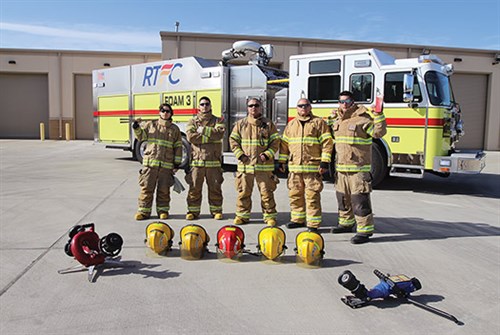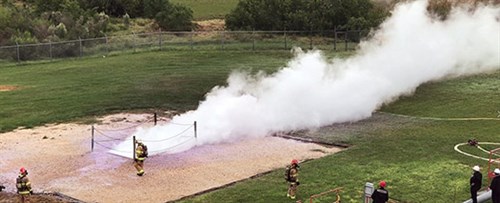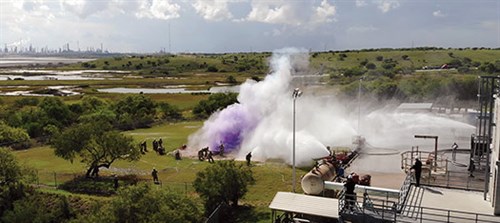LNG plant emergency response: Prepare, remain vigilant, execute
Have you ever heard of an “emergency reaction team?” The likely answer is “No.” Despite similar dictionary definitions for the words “react” and “respond,” much has been written about the differences between the two terms. Generally, a reaction is hasty, emotionally-driven and does not involve higher thinking. Conversely, response is methodical and meticulous, driven by preparation, and involves careful evaluation of the situation and application of past knowledge and training to address it—just what is needed in an emergency.
Responding vs. reacting is even more important in a liquefied natural gas (LNG) plant where the potential for fire and other hazards is present. The goal of any company operating such a facility should be to apply the science of emergency response preparation, readiness and execution to potential emergencies rather than simply reacting when something unexpected occurs.
Internationally recognized organizations such as the Society of International Gas Tanker and Terminal Operators (SIGTTO) and the International Group of Liquefied Natural Gas Importers (GIIGNL) have issued publications with guidance on LNG safety, including emergency response as one layer of safety. Additionally, countries hosting LNG companies issue regulatory guidance for LNG operations. In the U.S., the U.S. Department of Transportation’s Pipeline and Hazardous Materials Safety Administration (PHMSA) provides guidance on how to prepare a response for potential LNG emergencies in the Code of Federal Regulations (CFR) Title 49 Part 193—Liquefied Natural Gas Facilities: Federal Safety Standards.
Where potential exists for “smoke and fire,” specialists like those shown in FIG. 1 respond not only for firefighting, rescue and emergency incidents, but also for compliance with the PHMSA Part 193 regulations. The author’s Corpus Christi, Texas-based, not-for-profit company offers a unique perspective on the science of LNG regulatory compliance and emergency response based on its deployment of full-time, in-plant emergency response teams in two United States Gulf Coast (USGC) LNG export facilities.
 |
| FIG. 1. RTFC first response crew ready for action. |
Prepare—The U.S. LNG regulatory mandate. The U.S. PHMSA regulations for LNG under 49 CFR Part 1931 are written in a way that describes what to do without defining exactly how, providing flexibility to LNG facilities that may range in size from a small, peak-shaving plant to a multi-train, world-scale export terminal. The regulations address emergency response primarily in three paragraphs1:
- Paragraph 2509, Subpart F, “Emergency procedures,” requires operators to determine “the types and places of emergencies other than fires that may reasonably be expected to occur at an LNG plant,” and to manage each of these by following “one or more manuals of written procedures.” The paragraph also identifies four specific items that the procedures must cover: responding to controllable emergencies, recognizing uncontrollable emergencies and promptly notifying local officials, coordinating with local officials in preparation of an emergency evacuation plan, and cooperating with these same officials during evacuations and emergencies that require mutual assistance.
- Paragraph 2713, Subpart H, “Training: Operations and maintenance—Personnel qualifications and training,” requires that all permanent maintenance, operating and supervisory personnel be trained on the characteristics and hazards of LNG to conduct the emergency procedures under paragraph 2509 related to their assigned functions, provide first-aid, and numerous other non-emergency items.
- Paragraph 2717, Subpart H, “Training: Fire protection,” covers fire emergencies and requires maintenance, operations and supervisory personnel to be “trained according to a written plan, including plant fire drills…” to “…know the potential causes and areas of fire; know the types, sizes and predictable consequences of fire; and know and be able to perform their assigned fire control duties…”
Preparing an emergency response plan (ERP). The next step is understanding the manuals and procedures that address emergencies. Because the regulations dictate that a manual is required and training must be administered, personnel are left to deduce the manual contents based on the guidance.
LNG facility ERPs, in accordance with regulations, may contain the following:
- Identification of emergency events that may occur. This satisfies the regulations regarding types and locations of emergencies. LNG spills, refrigerant spills, fires, weather events and other emergencies are included.
- Description of facility emergency organization. Many companies elect to have facility personnel only fight “incipient” fires and provide basic first aid, calling onsite or external emergency responders for events that become uncontrollable. This is where industrial emergency response specialists, such as the author’s company, have a role.
- Description of offsite emergency organizations and agencies. This includes fire departments, ambulance services, law enforcement agencies and others.
- A contact list for company and external personnel, organizations and agencies. This list must be routinely updated as changes occur and includes all company personnel involved in emergency response and all external parties that may be involved in a response or require notification regarding an emergency.
- Definitions of controllable and uncontrollable emergencies. Any PHMSA inspector will look for this in the manual. According to Part 193,1 “Controllable emergency means an emergency where reasonable and prudent action can prevent harm to people or property.” Uncontrollable emergencies are deduced to be cases where “can” is replaced with “cannot.”
- Detailed descriptions of facility emergency and communications systems. This includes fire and gas detection systems, firewater systems, emergency shutdown systems, plant radios, public address/general alarm (PA/GA) systems, etc. Drawings and illustrations are included, usually in appendices, where needed.
- Evacuation procedures, training and drill guidance, and requirements for coordinating with local officials. Each of these address specific Part 193 requirements.
- Site-specific emergency response procedures. This is often included as an appendix to the ERP and addresses all emergency events identified for the facility. Many U.S. facilities utilize the National Incident Management System (NIMS) incident command system (ICS) structure.
- Appendices of supporting documents referred to in the ERP.
LNG facility ERPs are best written to address exactly what the Part 193 regulations require—this ensures satisfactory regulatory agency inspection results. When a U.S. LNG production facility is coupled with an export marine terminal, the United States Coast Guard (USCG) under 33 CFR Part 1272 also requires an emergency manual specific to the marine facilities under USCG authority.
Remaining vigilant: What a third-party emergency response organization can bring. Preparation is fruitless if skills are allowed to atrophy; maintaining a state of readiness is just as important as preparing for emergencies. For plant maintenance, operations and supervisory personnel expected to fight incipient fires and only participate in supporting roles at larger emergencies, this means initial training on LNG properties, emergency procedures—usually including ICS, first aid, evacuation, fire protection and fire drills—with continuing instruction at intervals of not more than 2 yr. Drills are especially important since the role-playing of “table-top” and “simulated” emergencies aids understanding and recall. Part 1931 mandates that plant fire drills provide personnel “hands-on experience in carrying out their duties under the fire emergency procedures…”
For most facilities, plant personnel utilize their skills gained in training to manage controllable emergencies but call for help with escalating or uncontrollable emergencies. This may involve an external fire department, an internal company emergency response team (ERT), or a specialist, full-time, in-plant emergency response team such as the 24/7 emergency response staffing solutions provided by the author’s company.
Many industrial facility operators have evaluated these options and realized that while external fire departments train on industrial fire-fighting and HAZMAT (hazardous materials) response, they focus their efforts on their primary customers: residential and commercial entities. Any operations manager that has ever fielded an ERT will testify to the challenges of paying overtime for coverage in the plant and training, trying to operate the plant when half the operators suddenly leave to respond to an emergency, and attempting to maintain the proficiency of personnel who are only “part-time responders.” Many operators have concluded that a specialist, third-party organization that solely focuses on emergency response is the best option.
For an organization that specializes in emergency response, the preparation and readiness to deal with an emergency is much more extensive. For example, a new recruit at the author’s company will receive ~14 wk of training covering National Fire Protection Association (NFPA) Codes and Standards 1, 10, 11, 12, 12A, 12B, 25, 30, 59A (LNG), 329, 471, 472, 600 (Facility Fire Brigades), 704, 1001, 1002, 1005, 1006, 1062, 1071, 1072, 1081, 1404, 1405, 1451, 1500, 1561, 1670, 1961 and 1983, in addition to various parts of the U.S. Occupational Safety and Health Administration (OSHA) 29 CFR 1910/1926 requirements and the American Heart Association CPR/AED First Aid courses. This training provides full coverage for industrial/marine/structural firefighting, emergency vehicle operations, HAZMAT response, rescue, inspection of fire protection equipment and ICS. Additionally, all recruits are required to obtain their medical EMT-B (Emergency Medical Technician, Basic) certification, which adds 6 wk of training. Paramedic training is optional. Continuing education maintains proficiency.
Equipment must also be kept in readiness (FIG. 2). A good third-party organization will conduct ongoing inspections of all fire hydrants, fire detection/alarm systems, building extinguishing agent systems, emergency lighting and exit signs, fire extinguishers, fire hose carts and reels, firewater main block valves, firewater hoses, foam carts and trailers, foam systems, storage tank-fixed systems, fire monitors, mobile apparatus and equipment, fire pumps, self-contained breathing apparatus (SCBA), air supplied respirators, control room emergency air, halon/dry chemical systems, deluge systems, eyewash/safety showers, fire doors and HAZMAT suits, among others. These systems and equipment require inspection, and having an onsite emergency response team conduct the inspections offsets part of their cost by eliminating the need for other third-party inspectors.
 |
| FIG. 2. RTFC ensuring emergency equipment readiness. |
Additionally, a good third-party emergency response organization will offer respirator fit testing/training, air monitoring, marine spill response, fire extinguisher training, incipient emergency response training, confined space entry pre-planning, industrial hygiene assistance and emergency procedures consultation. They will ensure regulatory compliance for emergency procedures, fire-fighting and regulatory mandated drills, providing training to plant personnel on all regulatory mandated initial and recurrent training and conducting periodic drills.
Responding when called upon. Before discussing how to respond to an LNG emergency, it is important to understand the properties of LNG. LNG is mostly composed of methane (CH4) and normally boils at approximately –260°F (–162°C), expanding ~600 times when the liquid turns to vapor. CH4 is the first to boil off, with ethane (C2H6), propane (C3H8), butanes and other substances following at higher boiling point temperatures. The flammable range of LNG vapors in air is 5 vol%–15 vol%, and LNG vapor normally will not explode unless confined, such as a leak in an enclosed space.
LNG vapors are colorless; however, because they are cold, they often condense moisture from the air, creating a white cloud that, in very humid environments, can be a good indication of a flammable mixture (FIG. 3). The initial vaporization rate after a spill of LNG can produce 10 ft3/min/ft2 of surface area (i.e., a 10-ft × 10-ft pool of LNG will create ~1,000 ft3/min of vapors). A similar spill of LNG on water generates significantly more, with as much as ~5,000 ft3/min of vapor generation.
 |
| FIG. 3. RTFC Training Academy live spill LNG training. |
For emergency response purposes, spills are classified as land/water and confined/unconfined. LNG facility design includes countermeasures for confining LNG spills for containment and, therefore, for vaporization rate stabilization. Unconfined spills are always producing vapor at the maximum rate at the leading edge of the spill where fully warm surfaces are encountered. These spills spread in a particular way as they flow downhill as a liquid, but create a vapor plume that travels downwind, creating a potentially broad and rapidly expanding vapor cloud.
LNG vapors produce a plume that can travel a significant distance before diluting to a point within the flammable range, and extreme amounts of radiant heat can be produced if ignition occurs. LNG vapors burn at ~2,426°F (~1,330°C), which is approximately 1.3 times the temperature of burning gasoline. In addition to the fire hazard, cryogenic LNG and vapors will cause severe frostbite if they contact human skin.
Any LNG facility emergency response plan will include “LNG spill with/without fire” cases. This is the primary aspect that makes LNG facilities different from other industrial process locations. For the LNG spill without fire case, cryogenic fluid contact with both personnel and equipment/structures poses great concerns. Unique “rules” for fighting an LNG fire include:
- Targeting an LNG fire with water will only increase the rate of vaporization and make the fire bigger.
- A condition called rapid phase transition (RPT) can occur with LNG, resulting in large “non-burning explosions” of vapor that break the sound barrier and make a loud “pop” noise, so it is important not to “puncture” the surface of boiling LNG or “break” the cushion barrier as it rapidly boils and moves across a surface.
- LNG fires are fought similarly to liquefied petroleum gas (LPG) fires, by isolating hydrocarbon sources (closing valves) and bleeding down or blowing down the pressure behind the leak or spill. It is preferrable to let the fire burn itself out rather than extinguish it and have it potentially re-ignite.
- Dry chemical, such as Purple-K, and high-expansion foam are important tools for fighting LNG fires (FIG. 4). Foam will not extinguish the fire, but it covers the surface, lowers the vaporization rate and allows a more controlled burn with less radiant heat. Dry chemical does not stick to the surface of LNG and smother the fire like in typical liquid hydrocarbon spills—it inhibits the chemical chain reaction, preventing the continuous burning of the gases even though a flammable range is present.

FIG. 4. Application of vapor dispersion water sprays and Purple-K dry chemical. - Due to the immense heat released from an LNG fire, it is important to consider positioning cooling water sprays and water application (fire streams) on adjacent equipment and structures, if possible.
- A condition called boiling liquid expanding vapor explosion (BLEVE) can occur when a fire impinges on a container, such as a pressure vessel or even a blocked-in pipeline holding the fluid, causing weakening of the container walls and catastrophic failure. Fortunately, this is considered a low probability event for LNG due to LNG tank design with insulation layers and storage at atmospheric pressures with well-designed pressure relief systems.
- Rescue emergencies at LNG facilities are similar to any facility; however, because many LNG facilities include a marine terminal, water rescue is added to trench and high-angle rescue scenarios.
Takeaways. Successfully resolving an emergency in an LNG facility begins with a thorough understanding of the applicable LNG regulations, continues with thorough and exceptional planning for potential emergencies, requires deliberate measures to stay prepared and ready for a real emergency, and ends with successful execution based on preparation and training.
While each facility operator must choose how it will ensure these successful outcomes, an excellent option is to contract a specialist, third-party organization with a sole focus on emergency response. These organizations not only maintain personnel preparedness through initial and recurrent training, but also continually inspect emergency equipment and systems in the LNG facility to be sure they are equally as ready to perform as the personnel. This is an investment that will pay dividends when needed most. GP
LITERATURE CITED
- U.S. Department of Transportation, “Pipeline and hazardous materials safety administration (PHMSA),” 49 CFR Part 193, 2022.
- Code of Federal Regulations, 33 CFR, Part 127, “Waterfront facilities handling liquefied natural gas and liquefied hazardous gas,” February 2022.
 |
Assistant Fire Chief RILEY MAXSON has 17 yr as an Industrial Firefighter with 12 yr of experience instructing industrial emergency classes. He heads the RTFC Training Academy, which provides emergency response training, including LNG, to clients both domestically and globally.
 |
MAURY HUDSON has 30 yr of hydrocarbons processing experience with more than 15 yr in LNG, where he helped place RTFC for emergency response in two USGC LNG export facilities. He consults for various industry clients, including LNG facilities.




Comments